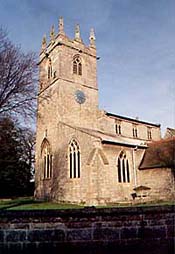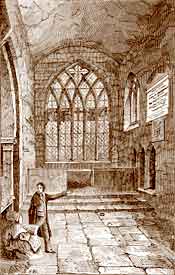REPORT ON RECENT LECTURES IN SUMMER 2001
NORTH NOTTINGHAM CHURCHES VISITATION: 9 June
Leaders: Jean Nicholson and Michael Jackson
 |
St Peter's church, Clayworth. |
All great journeys have a first step and the Thoroton Society started its visitation of all of the churches in Nottinghamshire by journeying to the north of the County. Ably led by Jean Nicholson, we went first through the salad days, or at least the celery fields, of Jean’s youth to Clayworth where we had coffee and visited the church -much restored in 1875. Noted for its outstanding wall paintings, we learned of the Laycock family and their place in High Society. West Stockwith was next, a beautifully light church built in 1722 in brick by the executors of a one-time ship’s carpenter. After visiting the White Hart our next call was Misterton, with its fragment of glass depicting a 15C Bishop in a north window and its John Piper window in the East – good to see that the Piper window gives its message from both the inside and the outside of the church. Next was Walkeringham with its monument to Francis Williamson. Tea was taken at North Wheatley with, for some of us, the first strawberries of the season. We walked up to the church with its primitive and rugged staircase up to the tower and passed on the way the Old Hall – an absolute riot of decorative brickwork. Many thanks to Jean Nicholson and Michael Jackson for setting the standard for our future visits. And to the spider, guarding the hand towel in Clayworth Village Hall!
Keith Goodman
LORD BYRON'S LAST JOURNEY: 11 July
Leaders: John Beckett and Ken Brand
 |
Byron's monument in Hucknall church. |
Members met at Radio Nottingham at the end of London Road – or one might say at the head of the Flood Road – and with slight variations due to changes in the street pattern the route of Byron's last journey was followed. Lord Byron's cortege left London for the family vault at Hucknall on 12 July 1824. The party reached the Flood Road in Nottingham at 5pm on Thursday 15th. The bells of St. Mary's church tolled as the cortege passed across Plumptre Square and along Fisher Gate and Carter Gate to the bottom of Hockley. The destination was the Blackamoor's Head, an old coaching inn on the corner of High St. and Pelham St. The procession moved up Hockley, Goose Gate and Carlton St. and then gently down Pelham Street. Byron's coffin was placed in the front parlour and the public was permitted to file past. The Nottingham Review reported "many thousands were admitted". John said this route was chosen as the slopes involved were less severe than, say, Hollowstone. Similarly the journey to Hucknall next day left the Market Place via Long Row, turning at Chapel Bar into Parliament St. and then to Milton St. and Mansfield Road, and so onto the Hucknall road. The sheer size of the crowds gathered to pay their respects and the narrowness even of a widened Clumber Street may have helped influence the choice of route. Nottingham townsfolk turned out in their thousands, when the funeral procession "extended a quarter of a mile." It had indeed become a public spectacle - but "the utmost silence prevailed." At strategic points John described aspects of Byron's life and the appearance and social life of Nottingham in 1824. I commented about the changes that had taken place: I hope they were of interest but I felt it did tend to upset the feel of 1824. There was a general response that it had been a good night out, and we had kept dry!
Ken Brand
Note: Byron's last journey and the contemporary layout of Nottingham, can be followed on H.M. Wood's "Plan of Nottingham in 1825" available at the Society's bookstall. Wood, the Borough's assistant surveyor and sometime Councillor, was to the rear of the procession that moved off from the Market Place on 16th July.
NOTTINGHAM'S VICTORIAN CHURCH HERITAGE: 26 July
Leaders: John Beckett and Terry Fry
The Victorians built churches as if they were going out of fashion. In the 20th century the bulldozer moved in: we are left with a random selection, from which four churches were chosen for this excursion. We moved through what John Beckett termed the three phases of church building, beginning in the 1840s with St John's, Carrington, largely sponsored by Ichabod Wright of Mapperley Hall. Terry Fry provided a potted history of the church, and pointed to some of its more idiosyncratic features. The second phase of church building followed the 1851 religious census, and took us to All Saints, where Arthur Bennett and Clarence Rickard, with a little help from Neville Hoskins, showed us around this beautiful T.C. Hine church, financed by William Windley. We visited two churches from the third phase of church building in the 1880sand 1890s. St Catharine’s (1896) a little known church on St Ann’s Well Road, by R.C. Clarke, was a gem, and Mrs Driver gave us an illuminating tour. St Stephen's, Hyson Green (1898), by W.D. Caroe in Arts and Crafts mode, replaced St Stephen's, Bunkers Hill (demolished in 1896) and thus this is a church full of artefacts often older than the building itself. John Beckett told us about the church, Rev. Ruth Worsley showed us around The Vine (1984), and long-time parishioners Eric and Christine Towle provided refreshments. This was an excellent afternoon out, all in bright sunshine. More than anything else it showed us just how frequently the Victorians built churches on a shoestring, while still obeying the rules and regulations of the Gothic revival. Only at All Saints, where money was less of a problem, was an architect given his head, with magnificent results. We were saddened to learn the church does not have a guaranteed future.